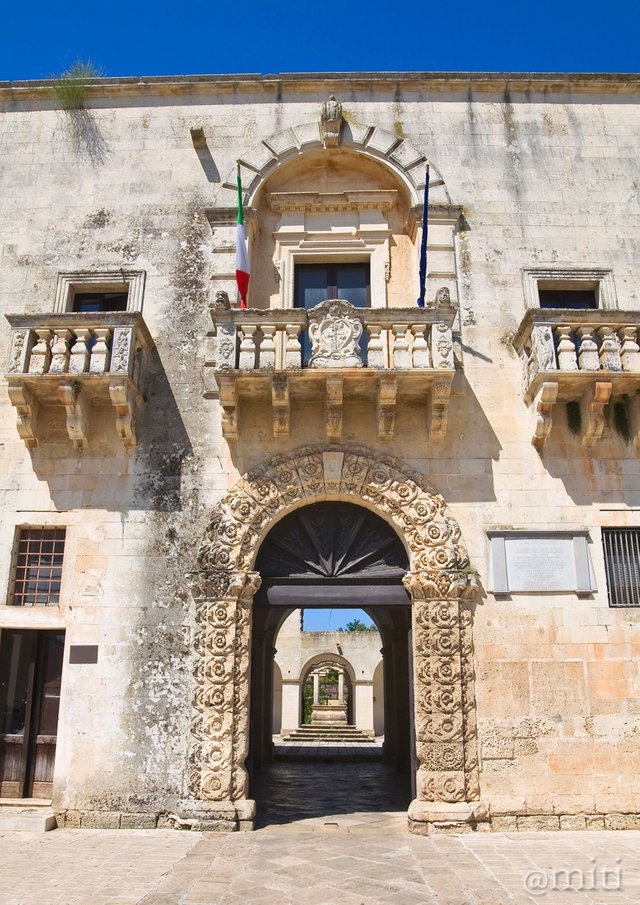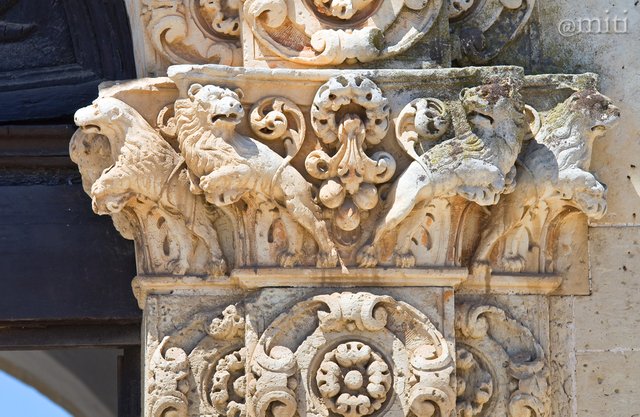A Journey through Italy: one photo every day #63 - STERNATIA [ENG/ITA]

The Convent of the Dominicans (Author's photo - All rights reserved)
Il Convento dei Domenicani (Immagine dell'autore - tutti i diritti sono riservati)



Ciao a tutti,
questo è un viaggio attraverso l'Italia. Posterò una foto al giorno con una brevissima descrizione. Spero vi piaccia!

Sternatia è un piccolo borgo della provincia di Lecce, nella regione italiana meridionale della Puglia. Si trova nella parte centrale dell'area della penisola salentina di lingua Grico.
Secondo alcuni storici "Sternatia" deriva dal greco e significa "percussione del petto", facendo così riferimento al gesto compiuto in un momento di dolore per la perdita di qualcuno che si ama. Tuttavia, ci sono altre ipotesi: il nome potrebbe significare "terreno lavorato" o "vigneto". Sternatia fu fondata durante la colonizzazione greca.
Anticamente, Sternatia era solo un Casale, sia sotto i Normanni, che sotto gli Svevi. Successivamente, fu venduta dagli Angioini alla famiglia Del Balzo nel 1301, che costruì le prime mura nel 1334. Nel 1352 divenne parte della Contea di Soleto seguendo la loro storia fino al 1463 con la morte del figlio di Raimondello, Giovanni Antonio Orsini Del Balzo.
Nel 1480 ospitò la sede dei soldati guidati dal futuro re di Napoli, Alfonso d'Aragona, quando Otranto fu assediata dall'esercito turco. Nel 1593 vi fu il barone Girolamo Personè e dopo di lui la famiglia Cicala e dal 1733 fino all'abolizione del feudalesimo nel 1806 il marchese Granafei.
La storia del paese è ancora oggi evidente nei suoi edifici e nella caratteristica forma del centro storico, con strade strette ed eleganti palazzi. La storia, tuttavia, è testimoniata anche da alcune antiche costruzioni, come il frantoio sotterraneo del XV secolo, recentemente restaurato, in cui i cosiddetti trappitari lavoravano per mesi consecutivi senza risalire in superficie.
Il centro storico ospita anche il Palazzo Granafei a pochi passi dalla chiesa madre. Alle porte del paese si può ammirare la cripta di San Sebastiano, costruita nella roccia. Da non perdere la Cappella di San Vito, di origine medievale, e la Chiesa della Madonna dei Farauli.
Fondato tra il 1491 e il 1513, il complesso conventuale dei Domenicani è dedicato alla Vergine Maria di Tricase. Il monastero è caratterizzato da un bellissimo portale, balconi e delle balaustre ad opera di De Riccardis.
Porta Filia e il tratto di mura adiacenti sono ciò che resta delle mura del XVI secolo. Nelle antiche mura esistevano altri quattro ingressi. Porta Filia è sempre stata di grande importanza per gli abitanti della zona, che perpetuano l'abitudine di far passare le spose per rappresentare l'accettazione della nuova famiglia nella comunità locale. Lo stesso rituale viene eseguito per le processioni funebri, per simboleggiare la fine della vita.
Cose da vedere: il centro storico, il Convento dei Domenicani, la Porta Filia e le mura, il Palazzo Granafei, la cripta di San Sebastiano, la Cappella di San Vito, la Chiesa di Maria SS. Assunta, la Chiesa di San Rocco, l'Ipogeo trappito, la Chiesa della Madonna dei Farauli.

Hello everyone,
I began a Photo Journey through Italy. I will post one photo every day with a little note of explanation. I hope you like it!

Sternatia is a small town in the province of Lecce, in the Southern Italian region of Puglia. It is located in the middle part of the Griko speaking area of Salento peninsula.
According to some historians "Sternatia" derives from the Greek and means "percussion of the breast," thus making reference to the gesture made in a moment of pain for the loss of someone you love. However, there are other hypothesis : the name might mean "tilled ground" or "vineyard." Sternatia was founded during the Greek colonization.
Sternatia was anciently only a farmhouse, both under the Normans, and the Swabian. Afterwards, it was sold by the Angevins to the family Del Balzo in 1301, who built the first walls in 1334. In 1352 it became part of the County of Soleto following their story up to 1463 with the death of the son of Raimondello, Giovanni Antonio Orsini Del Balzo.
In 1480, it hosted the headquarters of the soldiers led by the future King of Naples, Alfonso of Aragon, when Otranto was besieged by the Turkish military. In 1593 there was Baron Girolamo Personè and after him Cicala family and from 1733 until the abolition of feudalism in 1806 Marquis Granafei .
The history of the village is still evident today in its buildings and in the characteristic shape of the historic centre, with narrow streets and elegant palaces. History however is also testified by some old constructions, such as the 15th century underground olive mill, recently restored, where the o called trappitari used to work for months on a row without going back up to the surface.
The old town also houses the Granafei Palace just steps away from the mother church. At the gates of the town you can admire the crypt of San Sebastiano, built into the rock. Not to be missed are the Chapel of San Vito, of medieval origin, and Our Lady of Farauli.
Founded between 1491 and 1513, the convent complex of the Dominicans is dedicated to the Virgin Mary from Tricase. The monastery is characterized by a portal bearing the arms of De Riccardis balconies and balustrades.
Porta Filia and the stretch of adjacent walls are what remains of the sixteenth walls. In ancient walls they had four other inputs. It has always been of great importance for the inhabitants of the area, which perpetuate the custom to make you pass brides to represent the acceptance of the new family in the local community. The same ritual is performed for funeral processions, to symbolize the ending of life.
Thing to see: the historic center, The Convent of the Dominicans, the Porta Filia and the Walls, the Granafei Palace, the crypt of San Sebastiano, the Chapel of San Vito, the Church of The Assumption Of The Blessed Virgin Mary, the Church of Saint Rocco, the Hypogeum trappito, the Church of Our Lady of Farauli.

| Tipo di foto / Category | Paesaggio / Landscape view |
| Esposizione / Settings | 1/400 sec, ISO 200, f/11 |
| Camera | Nikon D5000 |
| Lente / Lens | Tamron SP 17-50mm f/2.8 XR Di II LD |
| Filtro / Filter | Polarizzatore Hoya / Hoya Polarizing filter |
| Cavalletto / Tripod | Manfrotto MKC3-P01 |
| Località / Location | Sternatia (Lecce), Italia |
| Software | Photoshop |


The Convent of the Dominicans (Author's photo - All rights reserved)
Il Convento dei Domenicani (Immagine dell'autore - tutti i diritti sono riservati)
A bit rough touch but seems very natural which makes human. :-)
Yes, that's true.
Non so come fai a beccare sempre le giornate con il cielo limpido ed azzurro che con il polarizzatore sembra un cielo dei Caraibi :)
Ahahah.. dicevo a qualcun'altro che essendo foto che vediamo in diverse agenzie, dobbiamo sempre cercare di scattare nelle condizioni migliori, quindi si programma la giornata migliore e soprattutto sempre d'estate.
Beh ciò non toglie che hai comunque una bella collezione di immagini riuscite visto il numero di post sul tema!
Grazie ;-)
Saluti amico miti, l'intaglio del convento dei domenicani è molto bello.
Si è vero, anche a me piace molto :-)
Excellent photography! Upvoted and following!
nice
Your comment is considered SPAM... Take a look in this guide:
https://steemit.com/steemit/@miti/a-complete-guide-for-newcomers-and-minnows-to-avoid-a-possible-spam-and-to-write-good-comments
It will help you.